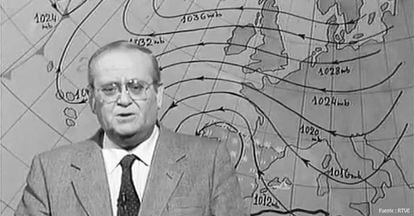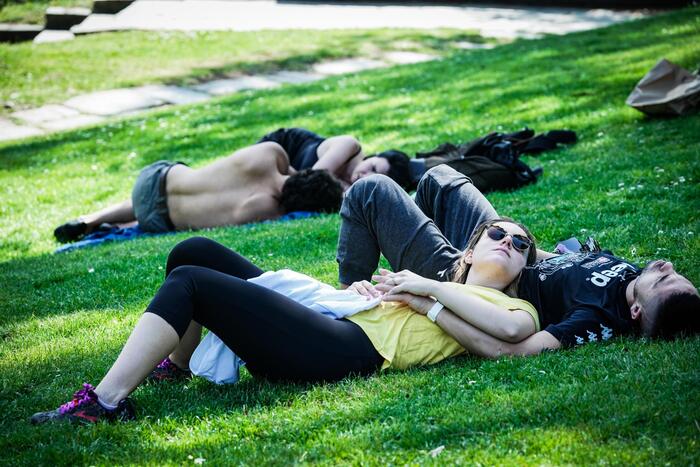As crazy as it is, time has a few basic factors and processes that don't change that much.
One of them is the Azores anticyclone.
This high atmospheric pressure system is key to the climate of the Iberian Peninsula, also modulating much of the climate of the rest of Western Europe and the east coast of the United States.
Now, a study shows that in the winters of the last decades, the anticyclone is bigger and more intense.
The authors of the work even maintain that such an anomaly had not been seen in the last millennium, which would be affecting the rains.
Acknowledging that something is up in the Azores, other climatologists don't go that far.
Simplifying it, the Azores anticyclone is a system of high pressures (weight of the air column, which is measured at sea level) whose center is usually in the middle of the Atlantic.
It forms a dance partner with the Iceland Depression, a low-pressure system and the source of most of the fronts that carry ocean moisture to Europe and, with it, rain.
The two phenomena form the opposite poles of the so-called North Atlantic Oscillation (NAO).
In summer, the couple grows larger and dances further north, cutting off the humidity.
It is what gives the Iberian climate that dry, stable and hot environment.
In winter, the Azores anticyclone shrinks before the Iceland depression.
Its displacement to the south gives free rein to the storms that make Galicia such a green place.
But this is changing.
Research just published in
Nature Geoscience
shows that the Azores anticyclone expands geographically beyond its usual limits with increasing frequency.
In addition, it is intensifying, with high pressures above the averages recorded in the past.
Caroline Ummenhofer is the main author of this research.
As a scientist at the Woods Hole Oceanographic Institution (United States), her laboratory investigates climate variability, with a special focus on the causes of extreme events.
And now they have focused on the Azores anticyclone: “Our study focused specifically on the winter months, since it is the main season in which the Iberian Peninsula receives most of its rainfall.
“Changes in the size and position of the Azores high pressures [during winter] have a major impact on moisture transport from the Atlantic”
Caroline Ummenhofer, researcher at the Woods Hole Oceanographic Institution, United States
Ummenhofer and other colleagues used various climate models to estimate winters when high pressures went beyond a threshold.
They fine-tuned them with atmospheric pressure data from weather stations spread across the region.
Those of Lisbon and the Azores Islands, for example, trace their records back to 1850. To go further back, they resorted to indirect climatic information kept by the stalagmites of a Portuguese cave eternally affected by the anticyclone.
They found that the number of anticyclones has not stopped increasing.
In the 20th century there were 15 extreme events, in which the Azores anticyclone was up to 50% larger.
The phenomenon has accelerated in the winter seasons in recent decades.
By comparison, in the previous 1,100 years, the average per century was 9,
"Our analyzes show that winters with an especially large Azores anticyclone coincide with unusually dry conditions on the Iberian Peninsula during winter," Ummenhofer details.
"By contrast, North Atlantic storm fronts strengthen further north, with Norway and the northern British Isles experiencing unusually wet conditions," she adds.
Mariano Medina, the first weather man on television, in an image from RTVE.
Four scientists, from paleoclimatologists to researchers from the State Meteorological Agency (AEMET), have had the opportunity to read Ummenhofer's work and agree with her that something is changing in the Azores anticyclone, but they are not so clear about its impact on the weather or what or who to blame.
“The best models available to study the climate of the last millennium show that greenhouse gases produce an expansion and intensification of the Azores anticyclone”
Pablo Ortega, climatologist and co-leader of the climate prediction group at the Barcelona Supercomputing Center
The climatologist and co-leader of the climate prediction group at the Barcelona Supercomputing Center Pablo Ortega published a paper a few years ago on how the oceanic circulation was weakening.
About this new work he says: “In the best models available to study the climate of the last millennium [those used in this study] it is seen that greenhouse gases produce an expansion and intensification of the Azores anticyclone, promoting drier conditions in the Iberian peninsula.
This response to greenhouse gases could explain the changes in the Azores anticyclone that have been seen in recent decades, the observations show them unequivocally”.
Models are just that, models.
They depend both on the entered parameters and on the actual observations available to refine them, and even on computing power.
This is one of the questions raised by the geologist and paleoclimatologist Armand Hernández, who in 2020 published an investigation on the evolution of the NAO over the last 2,000 years.
“They rely too much on models and only have one observable source of information such as speleothems [stalactites and stalagmites].
They could have used other records such as lake sediments or tree rings”, says the researcher at the Center for Advanced Scientific Research (CICA) of the University of Coruña.
For him, this weakens the conclusion that the current anomaly is the largest in the last millennium.
Sergio M. Vicente-Serrano has been studying rainfall and droughts for a few years as a CSIC researcher at the Pyrenean Institute of Ecology (IPE).
He acknowledges that models are necessary, but their results are not absolute truth.
In this case he does not see that there is a connection between the changes in the Azores anticyclone and what it rains on the Iberian Peninsula.
In fact, he says, "since 1850 we have had wet periods alternating with dry ones."
Another difficult issue to settle is that of guilt.
For Vicente-Serrano, "there is the problem of unraveling which part is due to climate change and which is due to natural climate variability."
The head of the Climate Assessment and Modeling Area at AEMET, Esteban Rodríguez, who considers this to be a robust piece of work, also agrees that something is happening with the Azores anticyclone.
“There is a clear relationship between the NAO situation and rainfall,” he recalls.
However, from the records that exist, dating back to the 19th century, "a rise in temperatures can be seen, but there is no clear trend in precipitation."
How is it explained that the main responsible for the fact that it rains or does not present such an anomaly and, nevertheless, it has not been noticed in a significant way in the precipitations?
Moreover, everything indicates that the Azores anticyclone will continue to enlarge and push the Iceland depression to the north.
However, reports from the Intergovernmental Panel on Climate Change (IPCC) do not expect a drop in rainfall.
"The NAO is responsible for 50% of the variability," recalls Hernández, from the CICA.
In other words, being the key factor, the Azores anticyclone is not the only one.
There are others in the dance, such as the melting that pulls the depression in Iceland to the north, the warming of the Mediterranean, which generates new inflows of humidity... For Rodríguez, from AEMET, climate change "is creating a new scenario ”.
You can follow
MATERIA
on
,
and
, or sign up here to receive
our weekly newsletter
.














